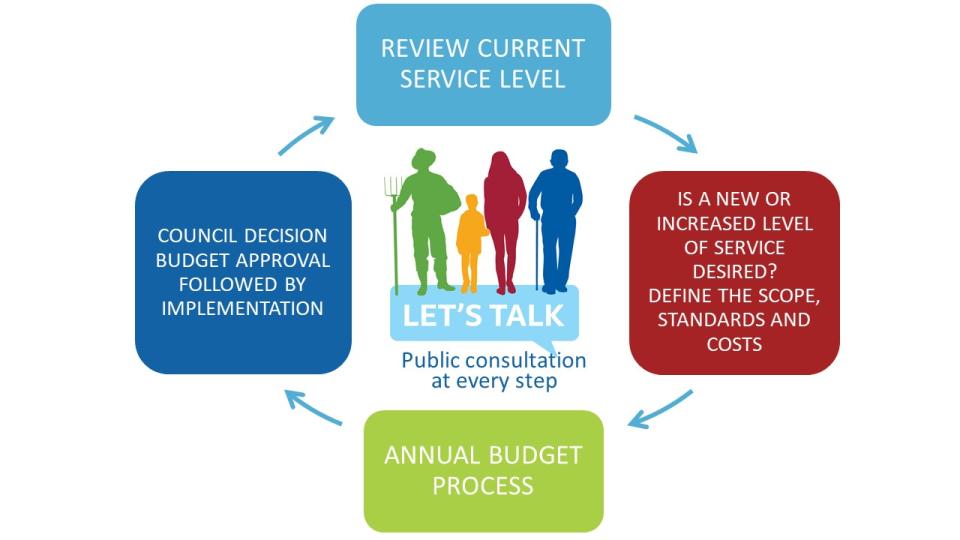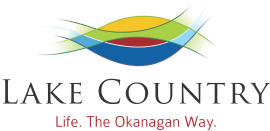"Levels of Service" principles are at the heart of how the District manages public assets and provides services to the community.
The District of Lake Country strives to deliver established and sustainable services that:
- Comply with legislated requirements,
- Protect and uphold public safety, community well-being and the environment,
- Reliably provide services to meet the needs of stakeholders and the community as defined by Council's Vision and Mission.
What are Levels of Service?
Municipalities provide communities with essential local and regional services such as clean water, sewer systems, parks and recreation and fire protection. Mandatory services such as potable drinking water, safety and the administration of the municipality's finances are regulated and must meet legislative requirements. Local Governments cannot adjust standards of mandatory services.
Optional services are provided at the discretion of Council and include policing, fire protection, garbage collection, transit, roads maintenance, sanitary sewer, parks maintenance and recreational programs.
Council decides what service to provide to the community and what resources to direct to it. Council may wish to provide more or less resources, or a higher or lower level of service, in a particular area depending on availability of resources and community goals.
Considerations for establishing Levels of Service
- Meaningful discussions on desired levels of service and prioritize the appropriate levels of service for the community.
- Considering whether it is a new service or whether it requires an alteration to an existing level of service.
- Review of the current level of service.
- Establish the capital and operational requirements to deliver the level of service.
- The annual budget process considers the cost of maintaining existing services and the benefits/risks of increasing or decreasing services based on growth, updated legislated requirements and public safety, environmental protection, sustainability and lifestyle expectations.
- Council decision on budget approval/tax increase to meet acceptable levels of service in all areas. Decisions made in the annual budget cycle are based on defined levels of service.

When considering an increased or decreased level of service, Council evaluates how multiple departments collaborate in the service delivery. If funding is diverted from one service to another, or levels decrease to increase another, the ramifications of the change must be carefully reviewed. New services or assets should not negatively impact the renewal and maintenance of existing services, facilities or infrastructure.
Understanding the Financial Aspects
A new service, or an increase to the existing service level, will increase costs and therefore requires additional funding. Council's goal is to maintain a balance between levels of service so there is enough funding and resourcing for the provision of all services.
Financial considerations when setting a Level of Service:
- The cost of delivering services goes up every year due to inflation and other factors, depending on the circumstances. Tax increases help keep pace and maintain the same levels of service as the previous year. Any new services or increases to existing levels of service require a further tax increase above and beyond the amount to address rising costs.
- Money is set aside in reserves for anticipated service level increases in future years. If the cost of delivering the service goes up more than the projection in the multi-year plan, decisions must be made to either lower the scope or standard, increase the duration of the program or fund the increased cost.
- Cost, especially as it relates to taxation, is a key consideration when defining levels of service but it is not the sole determining factor. It may be appropriate to define the level of service first and then determine the cost and the best way to fund it afterwards.
Allocating Resources Example
If Council decided to expedite additional sidewalks from the current 20 year timeframe to 10 years, additional funding would need to be added to Transportation Services. The money could be taken from other services (thus reducing those levels of service) or not change any existing level of service and instead provide additional funding from another revenue source, typically taxation.
How Can Community Members Get Involved?

Community members are invited to contact their Ward Councillor or Mayor and Council to discuss their expectations and priorities for the levels of service provided in the community. Council meetings are open to public participation in person or online.
Public engagement opportunities (both input and feedback) are developed for major projects and during the annual budget cycle. An online public engagement platform, Let's Talk Lake Country, is used to provide information and receive feedback from the public as well as arrange project-specific public meetings (open houses).
